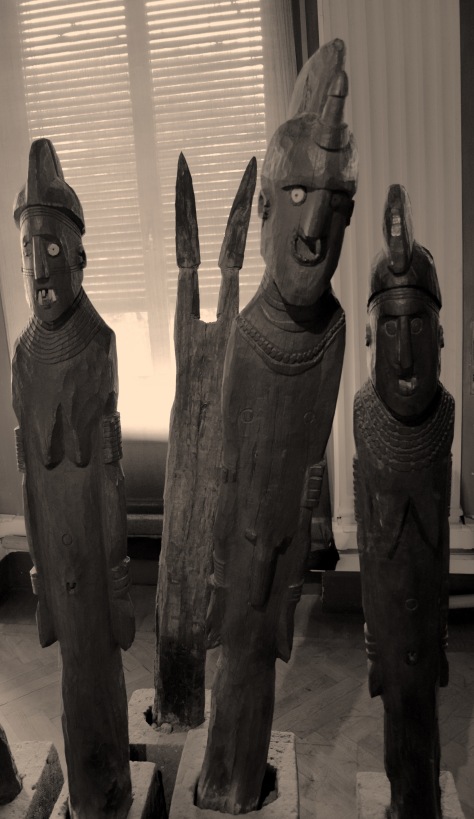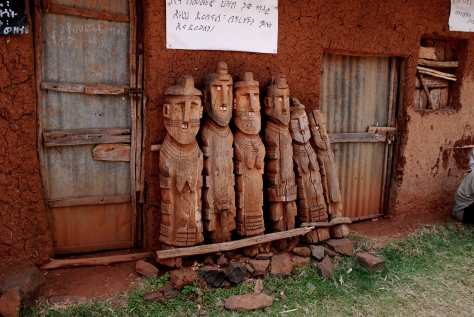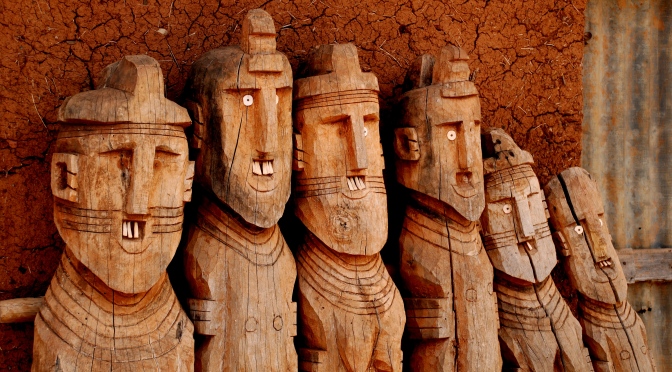Dr Suzi Richer, Postdoctoral Research Associate, Department of Archaeology, University of York

“The wakas are a form a material culture in which elements of the process of ‘breastfeeding’ are represented” (Watson 2009)
A couple of days ago, if I had been asked the question “What do the wakas represent?”, my first answer would not have been breastfeeding. But my interest was piqued. What has become clear whilst I’ve been reading around about the wakas is that context is key. Before I explain any further, let me take you back further in the story.
Much like Nina, I have been keeping-up with the developments of the Pallasboy Project from afar. Watching it unfold and seeing and hearing different people and their perspectives come into the project; it has given it a vibrancy and a feeling of ‘I wonder what they will do next…’ I was intrigued when Phase II: Anthropomorphic Wooden Figurines started as it was just before I was due to head to Konso in Ethiopia, where wooden anthropomorphic figurines, called wakas, are still part of life.
Konso is a UNESCO World Heritage site, famed for it’s extensive and terraced agricultural system. The project I work on, the Archaeology of Agricultural Resilience in Eastern Africa (AAREA), has undertaken excavation in the area working on understanding the history of these terrace systems. Unfortunately, due to political unrest in the area, I wasn’t able to visit Konso on this trip, but I was did visit the museums in Addis Ababa and manage to send some photos of these figurines to Ben before communication was locked-down in the city.
If I haven’t lost you by now, you might well be wondering what on earth do breastfeeding and agricultural systems have to do with the wakas? What follows is some key information that the archaeologist might be interested in (all based on Elizabeth Watson’s ethonography and history of Konso Living Terraces in Ethiopia: Konso Landscape, Culture and Development (2009)) and some reflections on them from an archaeological perspective.
What are wakas?
They are burial structures erected after the death of important men.
Where are they found?
In prominent places: public courtyards, at the entrance to a village, on well-worn paths.
What are they made from?
Several juniper trees.
Who makes them?
A specialist craftsman who ‘lives with the family for whom he is working. In addition to the payment for the work, he must be supplied with good food including meat, honey and alcohol during his stay’ (Watson 2009, 115).
(Mark – I think you need to make sure that this statement is upheld on the current project)
But what do the wakas depict?
The central figure is usually the main man, he is then surrounded by his wives, people killed by his extended family, or clan, and wild animals also killed by his extended family. This type of arrangement is displayed in the Ethnographic Museum of the Institute of Ethiopian Studies in Addis Abba (below).

There is something that draws your eye to the faces of these figures. Maybe it’s the eyes staring at you. And this is reflected in many of my photographs, the one by Senna (our archaeobotanist) at the top of the page and also if you do a Google image search for ‘Konso wakas’.

But broadening the gaze also brings in more information about these enigmatic figures. Thankfully Senna captured the setting of the wakas in Konso:

Bizarrely, it is actually the stones that are of interest here. They may not be in their original position, but they are part of the collection. And Watson (2009; 117) tells us that:
“Before the statues also lie stones which indicate…the number of fields that he acquired during his lifetime…The way in which each new field is represented alongside the number of wives…and the number of kills that he made, reflects not only the importance of having land, but the importance of acquiring land.”
And this is where ‘breastfeeding’ comes back in. There is much tied-in with the broader ideas of breastfeeding, the combining of bodily fluids, gender roles and the phallic head dresses of these figures – but that is another blog post. For now, let’s just explore the notion of ‘breastfeeding’. The men for whom these memorials are/were made are primarily poqalla, or leaders/chieftains. During their lives they are the ones to whom people turn in times of need (famine) and in celebrations (weddings). They give out grain if needed and people marry in the poqalla’s home, staying there and enjoying his hospitality for days afterwards. The poquallas do not demand repayment, so the metaphor of ‘breastfeeding’ is used within Konso to refer to this unconditional giving.
However, there is still the idea that nothing comes for free, and whilst support from the poqalla is given freely, it does result in the allegiance of people, which is shown through labour on land. In turn, more land can be cultivated, more food and surplus generated, and the produce converted into more land. The fields and how they are acquired are status symbols for the poqalla and his clan. Even after the poqualla’s death, more stones can be added to the waka as the clan’s holdings increase.
Our understanding of the historical Konso terracing system is changing as we excavate it, and that is partly due to the fact that we are also placing the detail within the wider landscape and social setting. The wakas provide another manifestation of the complex and interrelated agricultural system that typifies Konso.
So what does this ethnographic example from Ethiopia mean for archaeological examples of figurines from prehistoric Europe? Two things spring to mind: the wakas are not static, there are elements of them that continue to grow, change and evolve – they are about more than the life of the individual who they memorialise. In this example it wasn’t the actual figure that was added to, but the stones around it. Are there signs of reworking on the archaeological figurines? And if there are, where do they occur? Are the prehistoric examples likely to be fixed ‘memorials’ or something that could be altered and and reflected upon by the living?
And secondly, while we may be fixated on the object and the detail – like me with the eyes – what else is found around these objects? Where are they situated? Are they in situ or have they been moved? What else is known about the people who might have made them? Whilst we can’t talk to the people who made the prehistoric figurines, like we can in Konso, the questions that the ethnographic examples throw up might also be relevant to the archaeological examples.
Even though the wakas are still part Konso society, the wider clan/status/societal side of them is being steadily lost, especially once they have taken out of their original context. This is typified by the wakas in the Ethnographic Museum, which are isolated, have little contextual information and are akin to archaeological artefacts, which I suppose they are. Interestingly their current positioning in the museum makes them very hard to view (and photograph) as a whole unit, which is ironically how they were designed to be viewed when in situ. They are also only missing the stones.
Pallasboy Phase II has the potential to make some of these static figures move again. On many levels, there is much to learn from the movement and vibrancy of the project (as I alluded to at the start of this post); and on a practical level by recreating the figures, and making them ‘active’ again, we might be able to gain a glimpse into some the wider processes behind their initial construction.
Bibliography
Watson, Elizabeth E. 2009. Living Terraces in Ethiopia Konso Landscape, Culture and Development. Woodbridge: Boydell & Brewer.


Reblogged this on AAREA.
LikeLike
Reblogged this on Suzi Richer and commented:
This was originally posted on The Pallasboy Project website.
LikeLike